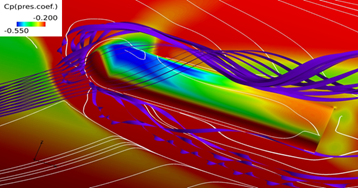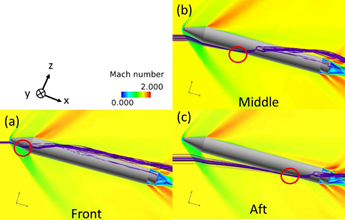The Effect of Protuberant Devices on Aerodynamic Characteristics of Slender Body Vehicle
JAXA Supercomputer System Annual Report April 2016-March 2017
Report Number: R16E0054
- Responsible Representative: Toshiaki Harada(Yokohama National University)
- Contact Information: Toshiaki Harada(harada-toshiaki-vt@ynu.jp)
- Members: Toshiaki Harada, Takuya Aogaki, Keiichi Kitamura
- Subject Category: Space(Rocket)
Abstract
It is important for rocket developments to quantitatively estimate the influence of protuberances in the flight vehicles which create asymmetry of flow around the vehicles and aerodynamic forces. Using fluid numerical computation, it is expected that we obtain a guideline for the protuberance choice in the future rocket development by conducting systematic and fundamental aerodynamic study on protuberance positions and sizes allowed to arbitrary flight vehicles.
Goal
In order to contribute to rocket development, we systematically clarify how the flow around the protuberances which are seen in flight vehicles affect aerodynamic characteristics of that vehicles.
Objective
We conduct numerical calculations for an axially symmetric rocket (cone-cylinder) that has a protuberance (hemisphere-cylinder), by changing i) location, and ii)size. From the viewpoint of aerodynamic characteristics, we provide a guideline for selection of protuberance positions and configurations.
References and Links
N/A
Use of the Supercomputer
We utilize JSS2 in order to perform expensive numerical fluid analyses around flight vehicles equipped with protuberances.
Necessity of the Supercomputer
It is unrealistic that this scale of numerical calculations be carried out with workstations in the university, requiring three million grid points. Therefore, we use JSS2 in order to ensure larger memories and to save the cost of numerical calculations.
Achievements of the Year
The protuberance (hemisphere-cylinder) was installed on the surface of rocket (cone -cylinder). Then, by changing its positions (1.front, 2.center of gravity, 3.aft of the rocket), we conducted numerical calculations. According to the results, changing the protuberance position affectedsupersonic aerodynamic characteristics of the vehicle, especially the roll moment, side force, and yaw moment. We found that the cause of these effects was the difference of the protuberance’s wake structures.

Fig.1:The streamlines around protuberance(protuberance position: center of gravity; angle of attack: 20 degrees)

Fig.2:The position at which the streamlines passing through protuberance hits the vehicle body (angle of attack: 20 degrees)
Publications
Presentations
1) Toshiaki Harada, Keiichi Kitamura, Satoshi Nonaka: Aerodynamic Analysis on Flight Vehicle with Protuberant Devices, ISTS 31st, Matsuyama, Japan, Jun 3-9, 2017.
Computational Information
- Parallelization Methods: Process Parallelization
- Process Parallelization Methods: MPI
- Thread Parallelization Methods: n/a
- Number of Processes: 124
- Number of Threads per Process: 1
- Number of Nodes Used: 4
- Elapsed Time per Case (Hours): 10
- Number of Cases: 45
Resources Used
Total Amount of Virtual Cost(Yen): 993,636
Breakdown List by Resources
| System Name | Amount of Core Time(core x hours) | Virtual Cost(Yen) |
|---|---|---|
| SORA-MA | 567,383.81 | 933,200 |
| SORA-PP | 4,899.15 | 41,828 |
| SORA-LM | 180.76 | 4,067 |
| SORA-TPP | 0.00 | 0 |
| File System Name | Storage assigned(GiB) | Virtual Cost(Yen) |
|---|---|---|
| /home | 9.54 | 60 |
| /data | 95.37 | 604 |
| /ltmp | 1,953.13 | 12,384 |
| Archiving System Name | Storage used(TiB) | Virtual Cost(Yen) |
|---|---|---|
| J-SPACE | 0.72 | 1,488 |
Note: Virtual Cost=amount of cost, using the unit price list of JAXA Facility Utilization program(2016)
JAXA Supercomputer System Annual Report April 2016-March 2017


